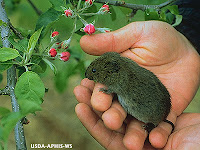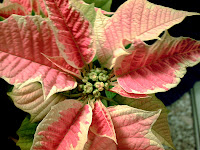Tips on Re-using the Christmas Tree
1. Win one for the "Chipper”. Mulching programs are a fast-growing trend in communities across the nation. Large chipper/shredders are used to grind up the trees, and afterward the mulch is made available for use in residents’ gardens. Municipalities or sometimes Tree Companies or Big Box Stores garner good will by contributing to this effort. Make sure the tree is cleaned of ornaments, hooks, tinsel, garlands, etc. and drop it off at a yard to be chipped. Or ask a buddy. A neighbor may have a chipper/ shredder and be willing to shred a couple of neighbors each year.
2. Bottle Trees. Old Christmas Trees are the perfect vehicle for creating some yard art. Using sharp bypass pruners or large, two-handed ratchet loppers, clip branches off at about 6-8 inches out from the trunk, eliminating those that are not spaced evenly around the trunk by cutting flush. Anchor the tree upright in the ground then mount your collection of long-neck colored glass bottles on the branch-stubs for a down-home style garden ornament that looks well as the sunlight sifts down through the glass. Use the branches that were removed to loosely cover tender perennials, leaving plenty of air surrounding the crowns.
3. Wildlife Habitat. The National Wildlife Federation suggests that wildlife need places to hide in order to feel safe from people, predators and inclement weather, and awards Certified Wildlife Habitat registration to home landscapes that fulfill many needs. Brush piles and dead Christmas trees are perfect hiding places. Lay the tree down in an out of the way area of the garden, perhaps near the wood pile or under cover of other evergreens to invite wild creatures to live at your home.
4. Bird Feeders. After removing all decorations prop the dead Christmas tree in the perennial bed and use it as a bird feeder and sanctuary. Hang with suet feeders, fresh fruit like orange or grapefruit halves, popcorn garlands, or seed feeders for thistle, black oil sunflower and millet seed.
5. Call in the Cavalry. Telephone for an appointment to have the Boy Scouts or an environmental non-profit group in the area pickup the tree and recycle it in return for a small donation (in the $5 range)
6. Barriers to Soil Erosion. Turn old trees into soil erosion barriers on river banks and lake shorelines. Use as beach stabilization to protect sand dunes and preserve beaches. Use dead trees as filters to manage delta sedimentation.
8. Fish Feeders. Back when we lived on a property with a half-acre earth-bottom pond, I submerged our old Christmas tree in the deep end to make a fishy refuge, egg-laying habitat and feeding areas for the bream, catfish, bass and bullfrogs to escape the alligator snapping turtle living there.
9. Be Crafty. Strip fragrant spruce or pine needles and put them in tiny cheesecloth drawstring bags to sweeten your next hot bath. Let the hot incoming water rush over them to make a fragrant soak. Or add a few to the dog's bed or hamster's cage to add a fresh, clean pine-y aroma.
10. Use mulch to pave Hiking Trails or Woodland Walkways. Parks, nature walks and larger properties use shredded evergreen trees as a free, renewable path material that is agreeable to the environment and cushions the steps of walkers and hikers!
As a Last resort: put the tree out on the curb. The solid green waste removal guys often haul the tree away. Many areas collect trees during regular pickup schedules during the two weeks following Christmas, although there are often requirements for size, removing tinsel, ornaments, limitations on flocked trees, and so forth. Chop the tree into 3 or 4 foot sections for easier removal and put it with the green yard waste container.
Living, rooted trees. To avoid recycling issues, next year choose a living, rooted (container-grown or ball and burlapped) tree and then plant it in your landscape after Christmas. There are plenty of options for choosing a tree. Pre-dig the hole while the soil is still soft at the beginning of December, then plant the tree immediately after Christmas, and remember, living trees have a better survival rate in mild climates like metro-Atlanta.
For Safety's Sake cautions people: do not burn a tinder-dry tree that is full of resin and apt to go up in an uncontrolled whoosh; not in the fire place and not even outdoors.




































